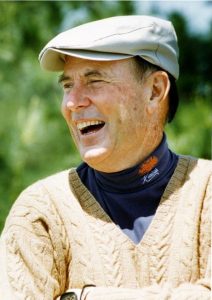
Photo info ...
Credit: IndyStarView Source
(Dec. 29, 1925-Jan. 9, 2020). Pete Dye is recognized as one of the most influential golf course designers of the late 20th and early 21st centuries. Referred to as the father of golf course architecture, Dye’s designs maintain global recognition for distinctive features such as small greens and the innovative use of railroad ties to stabilize bunkers. He honed his craft in Indiana.
Pete Dye worked and learned to play golf on a nine-hole golf course his father built on family property in Urbana, Ohio. He earned high school and state amateur golf championships before entering the U.S. Army in 1944 during World War II. While stationed at Fort Bragg in North Carolina for paratrooper training, he served as the greenkeeper on the base golf course. Upon his discharge, Dye moved to Florida where he met Indianapolis native, . The two married in 1950, started a family, and competed in several tournaments in the amateur golf circuit before relocating to Indianapolis.
In Indianapolis, Dye started Dye Insurance, where he distinguished himself as a $1 million salesman. Dye continued to compete in Indiana amateur golf tournaments, winning the Indiana Amateur Championship in 1958. He even qualified for the 1957 U.S. Open for professional golfers, though unsuccessful in emerging from the qualifying round.

In 1959, Dye changed careers to pursue golf course design. Dye’s first design was El Dorado, a 9-hole course in , Indiana. These nine holes have been incorporated into the Royal Oak course at Dye’s Walk Country Club in Greenwood. Dye’s first 18-hole course was created in 1962 in Indianapolis. Originally named Heather Hills, the course was renamed Maple Creek Golf and Country Club.
A trip to Scotland influenced Dye’s future course designs. There, he saw the benefits of small greens, pot bunkers, undulating fairways, and wooden bulkheads. Each of these elements added to fulfill Dye’s ambition to design increasingly challenging courses for an inherently difficult sport.
In the 1980s and 1990s, Dye designed numerous courses that are hailed as some of the best in the world. In all Dye designed public golf courses in 19 of the 50 states and 3 countries, the Dominican Republic, Guatemala, and Israel. He designed private courses in 20 of 50 states and 7 countries.
Dye’s work was not limited to original designs. He was acclaimed for his innovative renovation of The Kampen Course at Purdue University. Here Dye designed an environmentally friendly model for drainage and irrigation in wetland areas. His design recycled and purified water that drained onto the course and serves as a living laboratory at Purdue University. Students learn through turfgrass research and environmental studies.
In 2003, Dye received the Old Tom Morris Award from the Golf Course Superintendent’s Association of America. This award is the highest honor a golf course architect can receive.
Dye designed and created his last course in 2016. The Pete and Alice Dye Golf Experience, presented by Henry and Christine Camferdam, is located at the Riley Children’s Health (see and ) Sports Legends Experience at . The Children’s Museum course was Dye’s first designed as a mini-golf experience, where he replicated some of his iconic designs found at full-scale golf courses.
Other golf courses designed by Dye in , some with his wife Alice, include Brickyard Crossing at the , the Fort Golf Resort at , Eagle Creek Golf Club-Pines and Sycamore courses, and the Sahm Golf Course. In , the Bridgewater Club, Crooked Stick Golf Club, Plum Creek Golf Course, and Woodland Country Club were all designed by Dye. Other courses include Harbour Trees Golf Club in and the Club at Chatham Hills in . In , the Oak Tree Golf Course in also is a Pete Dye design.
The Golf Experience is part of the Pete Dye Golf Trail. Seven unique courses in Indiana make up a collection of courses for the golf traveler while showcasing the innovative designs of this legendary golf visionary.
Dye’s son Perry Dye, who died July 10, 2021, continued the tradition of designing golf courses. He had a distinguished career, building courses in 15 countries.

Help improve this entry
Contribute information, offer corrections, suggest images.
You can also recommend new entries related to this topic.